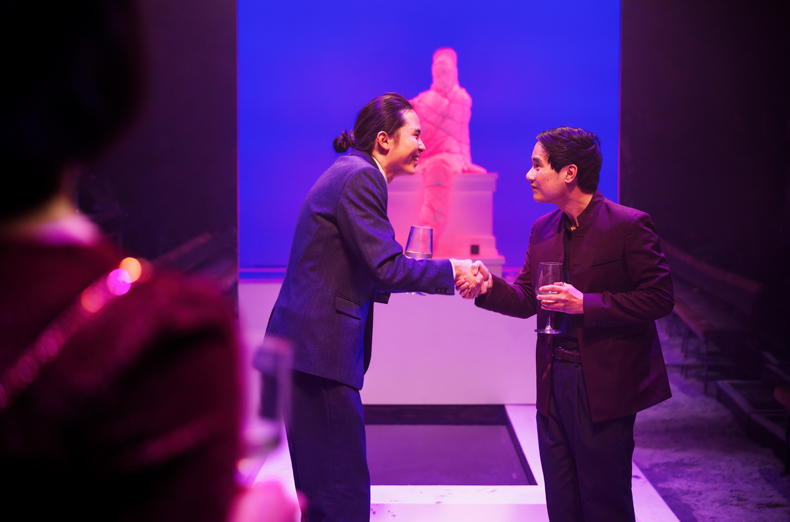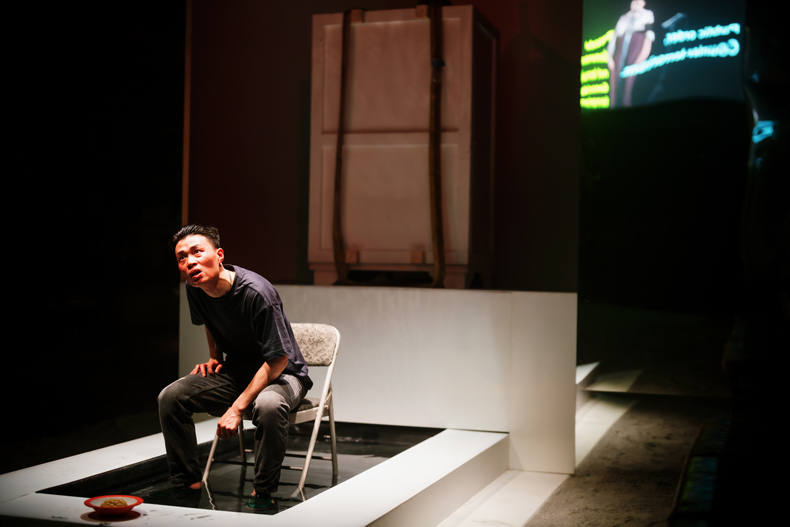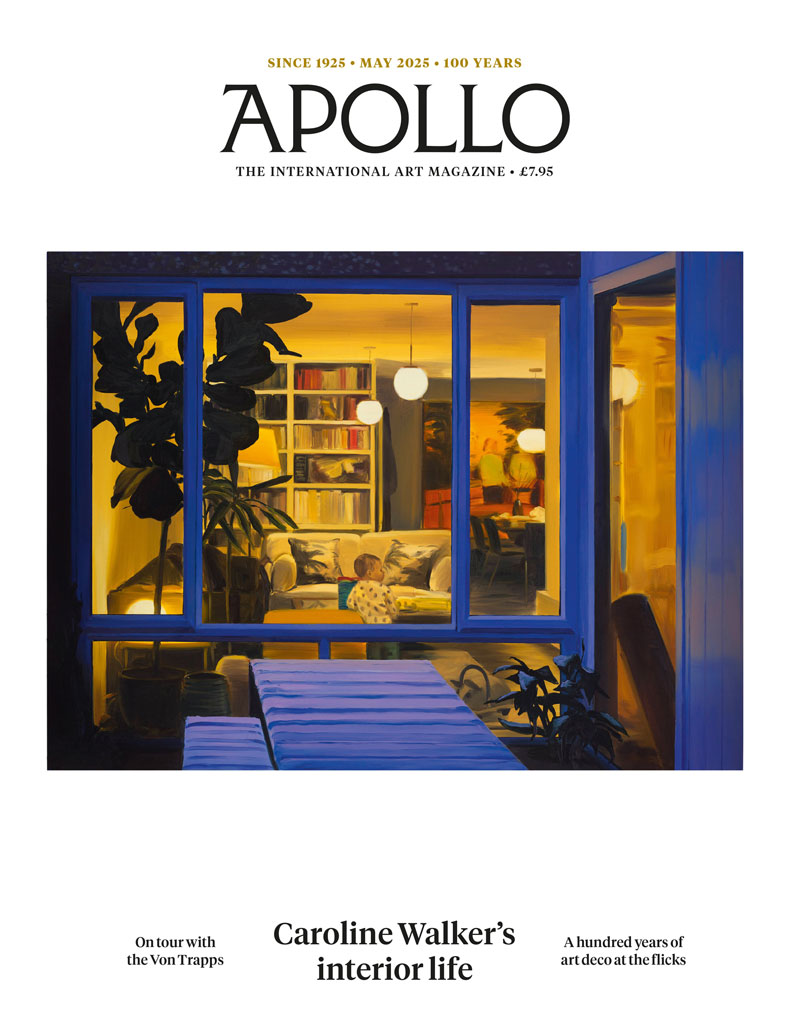Scenes from a Repatriation, a new play by the Singaporean playwright Joel Tan, gets a good deal of mileage out of what might seem like a niche subject: the restitution of contested objects. Given the range of people invested in their ownership or return, such objects lend themselves to vigorous exchanges of views, and Tan’s play features plenty of fiery dialogue delivered by characters who include students, protestors, museum curators, a billionaire collector, a human trafficker and Chinese officials.
The play revolves around the British Museum’s repatriation of a 12th-century Chinese statue – a Guanyin, a goddess of mercy and compassion – looted by British forces from the Qing emperor’s Summer Palace in 1860. The statue is fictional, but the raid and its reverberations in the present are very real, so the Guanyin is a handy dramatic device for refracting an array of contemporary concerns. The play presents a nuanced view of restitution by exploring how, when the receiving country is now a global power, the dynamic is not as clear-cut as it seems. Most powerfully in Tan’s telling, statues are migrants of a sort, with complicated pasts and uncertain futures.
Tan has explored art, censorship and authoritarianism in his previous work; he has suggested that in Singapore, playwrights often self-censor as a matter of course. He came to the UK in 2017 to pursue a master’s in dramatic writing, and spent seven years writing and refining Scenes from a Repatriation. The result is a thoughtful work that steers clear of didacticism or easy answers. Apollo spoke to him about the origins of the play and its thorny subject.

Joel Tan in 2025. Photo: © Alex Brenner
You’ve mentioned that you were inspired to write the play by seeing some statues in the British Museum. Which statues?
There’s a pair of Chinese statues [made in north-east China in the 17th century] in the Great Court. They would traditionally have looked out over spirit trails or family mausoleums and temples, but here they’re overlooking the gift shop. But the one that really upset me was the massive Amitabha Buddha in the stairwell of the North Stairs. I grew up in Singapore, and in Asia you see the reverence with which objects like that are displayed, whether in temples or not. I found its placement in the stairwell very aggravating.
The Amitabha Buddha, which dates from the 6th century, was given to the British Museum by the Chinese government in 1938. Is that something you were aware of – and does it complicate your sense of how the statue embodies the relationship between the two countries?
I was aware of it. Though the statue in the play is a fictional creation, I was interested in art as a way of leveraging soft power and brokering diplomatic relationships, particularly how the Chinese government might [use it to] try to assert itself on the world stage. Art is a symbol of cultural richness: ‘great’ nations have ‘great’ art, right? There’s this constant interplay between power, art and politics.
In Singapore, there’s something quite similar at work: sometime in the ’90s we suddenly decided that we wanted to become a hub for the arts, when previously the arts had not been a concern for the state at all. It was all part of branding ourselves as a global city. There’s something about how art can play in this area where hard politics cannot.
Have Chinese attitudes towards the country’s historic material culture changed significantly in recent years?
I think so. There’s been a kind of turn in China towards traditional arts and a shoring up of several centuries of cultural history. There’s also been a resurgence of certain kinds of religious practices, particularly Taoist practices, after Mao. I’m not sure what that’s about, but I think it’s this idea that great nations have deep cultural and spiritual practices, and it’s tapping into something that was so brutally dismantled during the Mao years. It might also be a way of counterbalancing the rapacious capitalism of the past couple of decades. But I do think things have changed.
When you go to the British Museum now, the China [and South Asia] gallery is constantly flooded with Chinese tourists. We spoke to a couple of them about how it feels to be looking at these ancient Chinese artefacts in a foreign museum. A couple of people said it was really interesting because it’s stuff they couldn’t necessarily see back home. There’s definitely a kind of craving among many Chinese people to access these artefacts of their material culture.

A protestor stands in front of the Guanyin, a fictional 12th-century Chinese statue returned to China by the British Museum, in Scenes from a Repatriation (2025) by Joel Tan. Photo: © Alex Brenner
The Chinese government was given the Amitabha Buddha by C.T. Loo, a dealer of Chinese antiquities who is now regarded as a problematic figure, as much trafficker as dealer. Such figures complicate the moral high ground we tend to attribute to those on the receiving end of imperialism.
There was a version of this play where C.T. Loo had a more pronounced role. Given my own migrant Chinese history, I guess I was just really interested in opportunistic Chinese migrants. The way he kind of stumbled into the art trade is also fascinating. He’s a really polarising figure in China: some see him as a traitor to the race, while others attribute the survival of a lot of art to him. I’m really interested in these grey areas.
Also, when you’re looking at stories of empire, colonisation and men on the ground, it’s very difficult to pin people down as villains or heroes. Everybody’s just kind of caught up in the muck of it. Even Lord Elgin, who ordered the burning of Yuanmingyuan – it’s not as clear-cut as it sounds, because it emerged that he actually targeted the emperor’s summer palace to minimise civilian deaths. So how do you measure the brutality of burning down the palace with this kind of high-minded, gentlemanly impulse? It’s all really grey and murky and hard to wrap one’s head around.
China has been less vocal than other countries when it comes to demanding the return of objects that were plundered from it. You suggest in the play that that’s because China can be convincing in more back-channel ways, rather than having to resort to the court of public opinion.
One of the most interesting stories I read in relation to this is that [Chinese parties] just went to get it themselves. There were a bunch of military-grade art heists in some Scandinavian museums in recent years, where objects from Yuanmingyuan were specifically targeted. The thieves took only objects that had been taken from China during European wars. One theory is that they were sponsored by some patriotic billionaire: of course, in China, patriotism is a business as well.
I found it really interesting that [these parties] weren’t going to wait for these lengthy restitution processes. One of the objects reportedly ended up being displayed in Shanghai Pudong International Airport. It’s all so blatant, and the museums can’t really do anything about it: what are they going to do, ask for their stolen art back?
So because of the incredible financial resources that have amassed in China, there’s maybe a bit more freedom to act and exert pressure in [certain ways]. With Greece and some African nations, there’s a kind of stalemate in the [restitution] conversation because the relative political and financial power isn’t the same. I was speculating: if China really wanted something back, how would that conversation go?
There’s a scene in the play that refers to Yves Saint Laurent’s ownership of two 18th-century bronze relics from Yuanmingyuan. François Pinault eventually returned them to the Chinese government in 2013 – as a ‘gift’. It’s a reminder that only the powerful can be magnanimous.
Yeah. That’s the case with the British Museum, too, with its high-minded long-term loans. Though its hands are tied by the British Museum Act, it’s ultimately still saying, ‘Ownership lies with us, but we’ll deign to loan these objects to you.’ The idea of the gift feels quite interesting here: it implies that it’s in our power and authority to return them.
What I found fascinating was this idea of very wealthy Europeans collecting these spoils of war and then being confronted with their provenance and a claim for return. [So they] cite things like Tibet and human rights abuses in China as a kind of moral leverage. There’s a moral difficulty when it comes to thinking about Chinese victimhood. It’s part of my speculation about how a Chinese claim would really differ from claims from some other parts of the world.

A low-level businessman shakes hands with a Chinese billionaire who has recently taken possession of the Guanyin, a fictional 12th-century Chinese statue, in Scenes from a Repatriation (2025) by Joel Tan. Photo: © Alex Brenner
Those bronze relics were designed for the Qing emperor by an Italian. It reminds me of a point you make in the play about everything being from somewhere else, which complicates the idea of any one object being a pure symbol of a nation’s cultural heritage.
Exactly. Much of Yuanmingyuan was actually designed by Jesuit architects and there were a lot of Italian painters in the Qing court. As closed off economically as Qing China was, there were still these flows of capital and ideas. That’s been true of China for centuries.
So the idea of cultural purity and authenticity is a myth. Leveraging those ideas and feelings can be really potent but also quite distortive. The Opium Wars, for instance, are the starting point of a certain nationalist narrative about modern Chinese history, at least within China: the wars are said to have marked the beginning of a century of national humiliation. There are mandatory courses in Chinese universities where you learn how modern Chinese history kicked off with the Opium Wars. But this story of bullying and humiliation hides the fact that there was a lot of robust engagement between China and the West for many years. It manifested in a fascination with Western architecture and decoration and art. There was a flow of goods and people over centuries; China wasn’t just invaded overnight by a bunch of white people. But the idea of cultural purities can be weaponised in the service of nationalistic ideas.
In your opinion, how important is the difference between restitution and repatriation?
I was interested in the movement and flow of bodies, hence the migrant scene in the airport towards the end of the play [in which a would-be migrant starts getting cold feet and his trafficker attempts to convince him to go through with it]. Repatriation captured that a lot better than restitution. There’s something quite cold about restitution as an act of return: it feels like the language of institutions, whereas repatriation implies migration and bodies and the politics that comes with that.
I suppose repatriation, more than restitution, makes certain statues easier to co-opt into nation-building exercises – their physical presence has a charge that title deeds just don’t.
Exactly. It goes back to that point about how the story of the Opium Wars eventually flowed into the establishment of the Chinese Communist Party and its nationalist policies and its relationship with the West. That’s why the play is split into two distinct parts: the first half is set in the UK, the second half in the PRC. I wanted to dig into the dark heart of what happens when you allow these brutal nationalist logics to take root, and how bodies and people are broken in the process. It was quite heartbreaking to think of this specific statue being caught up in all of that: an expression of motherly mercy becoming a pawn in a violent nationalistic tussle.

A historical scene, involving a British soldier and a Chinese woman at the sacking of Yuanmingyuan in 1860, plays out in the foreground while in the background, in the present day, a 12th-century Chinese statue is removed from the British Museum in Scenes from a Repatriation (2025) by Joel Tan. Photo: © Alex Brenner
At one point, one of the characters says that the story around the artwork matters more than the artwork itself. Do you agree?
Probably not. There’s a lot of weight to what that character says: the story of the return of the Parthenon Marbles or Benin Bronzes would be very, very powerful for people. It’s the story around the theft of these objects that energises a lot of these conversations. Sometimes I wonder if people know more about the story than they do about the art. When you’re in front of the object and you consider its materiality and the spiritual weight it holds, it exerts a kind of power that I find undeniable. When I go to ethnographic museums and stand in front of these contested objects, I do feel like the most important aspect of them is their spiritual quality.
Part of the argument that the play is making is that these objects absorb spirits, sounds, images and impressions, which is why there are so many people in this play. Every person who’s encountered the object gets absorbed a little bit into its signature. The controversial story is only one strand of any contested object’s history.
The play is ambivalent about what China does with its returned statues – in your telling, it politicises and weaponises them. Yet it’s still indefensible for the UK to hold on to statues it stole.
There’s this idea that once you return the object to its land of origin, it’s no longer your problem. The moral weight of return is undeniable – the fact that many objects entered the UK through bloody, brutal means is enough to make the UK seriously consider returning them – and a lot of these arguments about the capacity of the [receiving country’s] museums to house and conserve these objects feel to me like an excuse. I don’t think the play itself is making a specific argument for what should happen. I don’t think a play could answer that question.
The way the play collapses past and present is pertinent – it reminds us that attitudes haven’t changed all that much. Even in the 19th century, people thought what France and Britain were doing was wrong. Victor Hugo, in 1861, said, ‘I hope that one day France will return this booty to plundered China.’
There’s a kind of historical snobbery that can come with looking at the past – imagining that they were more savage and we are more enlightened. My sense is that you can never be a witness to this kind of brutality and not feel really disturbed by it as a human being. Many Brits, reading accounts of men on the ground in the Opium Wars, were disgusted with what was happening. There were these horrific stories of war, and a lot of condemnation, which we kind of forget about. These conversations were alive at the time in the same way they are now. I feel like it’s important that the play collapses time, because these objects do something similar: they’re in front of us in the present, but they collapse all these histories inside them.

A satirist who has published a cartoon depicting the Guanyin, a fictional 12th-century statue returned to China by the British Museum, is interrogated by Chinese authorities in Scenes from a Repatriation (2025) by Joel Tan. Photo: © Alex Brenner
Scenes from a Repatriation is at the Royal Court, London, until 24 May.



 How the return of Asante gold is going down in Ghana
How the return of Asante gold is going down in Ghana










![Masterpiece [Re]discovery 2022. Photo: Ben Fisher Photography, courtesy of Masterpiece London](http://zephr.apollo-magazine.com/wp-content/uploads/2022/07/MPL2022_4263.jpg)
Suzanne Valadon’s shifting gaze